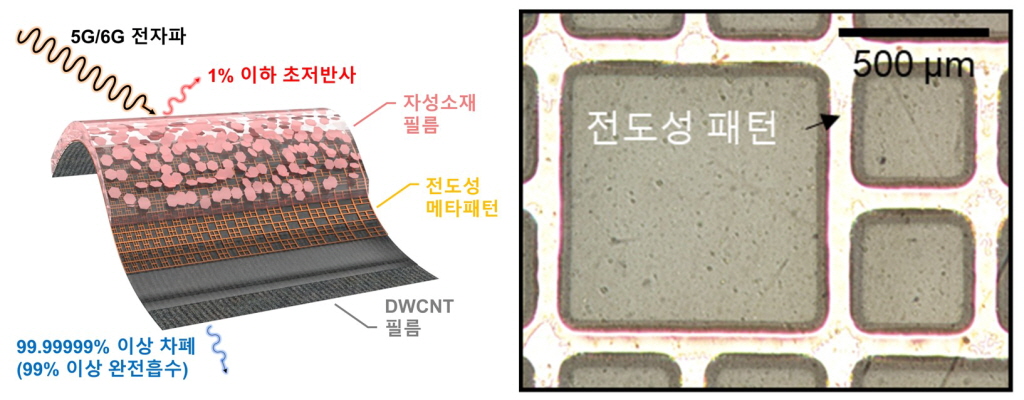한국재료연구원(KIMS, 원장 최철진) 융·복합재료연구본부 박병진, 이상복 박사 연구팀이 하나의 소재로 다양한 주파수 대역의 통신 전자파(5G/6G, WiFi, 자율주행 레이더 등)를 동시에 99% 이상 흡수할 수 있는 극박 필름 형태의 복합소재 기술을 세계 최초로 개발했다.

▲연구팀이 개발한 전자파 흡수차폐소재 개념도와 설계된 전도성 패턴
재료硏, 다중대역 전자파 동시 흡수소재 세계 최초 개발
얇은 필름 한 장으로 전자파를 완벽하게 흡수할 수 있는 소재가 개발돼 향후 롤러블 폰이나 웨어러블 기기에서 적용이 가능할 것으로 기대가 모아진다.
한국재료연구원(KIMS, 원장 최철진)은 융·복합재료연구본부 박병진, 이상복 박사 연구팀이 하나의 소재로 다양한 주파수 대역의 통신 전자파(5G/6G, WiFi, 자율주행 레이더 등)를 동시에 99% 이상 흡수할 수 있는 극박 필름 형태의 복합소재 기술을 세계 최초로 개발했다고 8일 밝혔다.
해당 전자파 흡수차폐소재는 0.5mm 이하의 두께로 3개의 다양한 주파수 대역에서 1% 이하의 낮은 전자파 반사율과 99% 이상의 높은 전자파 흡수율을 가진다는 것이 장점이다.
전자부품에서 나오는 전자파는 다른 전자부품에 간섭을 일으켜 성능저하 문제가 발생한다. 이를 방지하고자 전자파 차폐소재가 쓰이며, 전자파 간섭 문제를 최대한 줄이기 위해서는 전자파를 반사하는 것보다 흡수하는 것이 확실하다.
반면에 기존 전자파 차폐소재는 전자파의 90% 이상을 반사하고 실제 흡수율은 10%에 불과한 경우가 많았다. 또한 흡수율이 높은 소재라 하더라도 특정 단일 주파수의 전자파만 흡수하는 한계도 있었다.
연구팀은 이를 극복하고자 하나의 소재로 여러 주파수의 전자파를 동시에 흡수하는 복합소재 기술을 개발했다. 본 기술은 전자파를 흡수해 제거하는 방식으로 전자파의 2차 간섭 문제를 해결하는 게 가능하다.
또한 얇고 유연한 소재로 만들어 수천 회 이상 접었다 펴도 형태를 그대로 유지할 만큼 우수한 성능을 갖춰 롤러블 폰이나 웨어러블 기기에 활용이 가능하다.
연구팀은 페라이트 자성소재의 결정구조를 변화시켜 원하는 주파수를 선택적으로 흡수할 수 있는 원천 자성소재를 합성했다. 이를 얇은 고분자 복합소재 필름으로 제작했으며, 필름 후면에 전도성 패턴을 삽입해 전자파의 진행을 제어했다. 전도성 패턴의 형상을 변화시키면 원하는 주파수에서 전자파 반사를 극단적으로 낮출 수 있다.
또한 최후면에는 고차폐성 탄소나노튜브 박막을 부착해 전자파 차폐 성능을 극대화했다.
연구책임자인 재료연 박병진 선임연구원은 “5G/6G 통신의 적용처가 확대됨에 따라 전자파 흡수차폐소재의 중요성이 더욱 부각되고 있다”며 “해당 소재로 스마트폰, 자율주행차 레이더 등 무선통신기기의 신뢰성을 크게 높일 수 있을 것”이라고 말했다.
본 연구성과는 한국재료연구원의 기본사업과 국가과학기술연구회 전자파솔루션융합연구단(SEIF)의 지원을 받아 수행됐다. 연구 결과는 세계적 학술지인 ‘어드밴스드 펑셔널 머터리얼스(Advanced Functional Materials, 제1저자:박병진 박사)’에 10월 1일자 표지논문으로 게재됐다. 연구팀은 국내특허 등록을 완료했으며, 미국과 중국 등 해외에도 특허를 출원한 바 있다. 또한, 국내의 여러 소재기업에도 기술이전을 완료해 실제 통신기기 및 자동차에 적용하는 과정이 진행 중이다.
